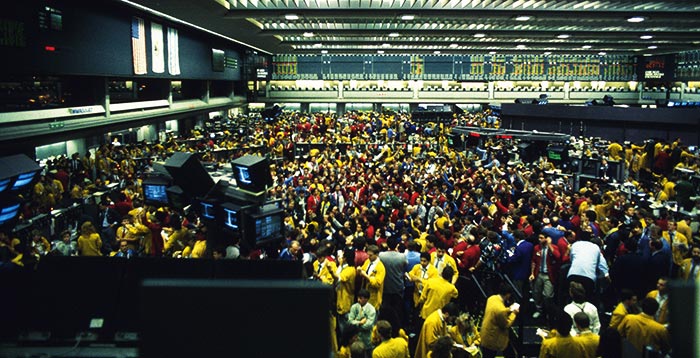
I remember bringing guests onto the floors of the New York Board of Trade, ICE, and NYMEX. The setting was impressive, the noise deafening, and the electric energy amazing. There were times when the increase in decibel levels alerted traders that something was happening in a pit, and the traders would all run over, like a thundering herd of cattle, to catch a piece of the action.
While the scene appeared chaotic to the casual observer, there were many strict rules of engagement and a definite discipline to all of those waving arms and hand signals. It was also a form of “active management” in the purest sense, where traders were very protective of their capital and not hesitant to exit a losing position at warp speed, or to let a winner run as far as it could.
We were market makers, traders, and floor brokers, and some of our very favorite trades were based on volatile stocks, especially tech stocks. A typical trade was to purchase an at-the-money call and a put, also at-the-money. We would buy these options on the day before or the day of an earnings release and watch with great interest after the market close as earnings were reported.
The next day we would take profit on the side of the trade that had made money, either the put or the call. We always knew when purchasing the options that one side would become worthless and the other would make money. The downside risk, of course, would be to see the stock with flat earnings and little volatility the next trading day, with both sides of the trade losing money.

This type of trading can be employed in today’s markets with many high-flying, expensive stocks that can run dramatically to either the upside or the downside. Take a look at what happened with Apple’s options during Q2 earnings. Before the market close on the day of Apple’s earnings report (7/21), the August 133 call was priced at $3.70, and the August 133 put cost $4.60. Apple stock had traded that day in a range of $130.32 to $132.92.
Earnings came out, and though the official press release announced “record results,” traders viewed them more like kennel club contenders. Those same options traded the next day at $2.55 for the August 133 call and $8.84 for the August 133 put. On the call you would have lost $1.15, but on the put you would have made $4.24. You would have made $3.09 by purchasing the options “straddle” and then exiting on the following day. While $3.09 might not sound like much, remember that each options contract represents 100 shares of a stock—so we are really talking $309 per contract. Traders have been known to buy astoundingly large positions in each options contract.
This particular strategy tends to work best for stocks that release their earnings after the close, as trading moves can become highly exaggerated and carry into the following day. Watch the strategies and place paper trades to see which candidates work best. See how many of these types of trades make money and how many fail to perform.
Remember, there is no reason to purchase options that are far out-of-the-money (though the prices will be far less), nor is there a reason to buy these options more than a day or two before earnings. While this type of trade might be viewed as traders “gaming” earnings reports, keep in mind that options trading is serious business. Understand all of the risks (and the potential rewards) before you wager your hard-earned money.
The opinions expressed in this article are those of the author and do not necessarily represent the views of Proactive Advisor Magazine. These opinions are presented for educational purposes only.
 Jeanette Schwarz Young, CFP, CMT, CFTe, is the author of the Option Queen Letter, a weekly newsletter issued and published every Sunday, and "The Options Doctor," published by John Wiley & Son in 2007. She was the first director of the CMT program for the CMT Association (formerly Market Technicians Association) and is currently a board member and the vice president of the Americas for the International Federation of Technical Analysts (IFTA). www.optnqueen.com
Jeanette Schwarz Young, CFP, CMT, CFTe, is the author of the Option Queen Letter, a weekly newsletter issued and published every Sunday, and "The Options Doctor," published by John Wiley & Son in 2007. She was the first director of the CMT program for the CMT Association (formerly Market Technicians Association) and is currently a board member and the vice president of the Americas for the International Federation of Technical Analysts (IFTA). www.optnqueen.com
